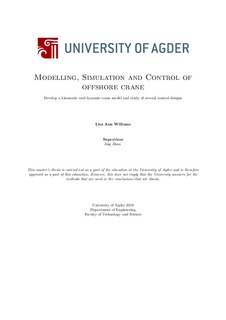| dc.contributor.author | Williams, Lisa Ann | |
| dc.date.accessioned | 2018-09-24T08:41:52Z | |
| dc.date.available | 2018-09-24T08:41:52Z | |
| dc.date.issued | 2018 | |
| dc.identifier.uri | http://hdl.handle.net/11250/2564033 | |
| dc.description | Master's thesis Mechatronics MAS500 - University of Agder 2018 | nb_NO |
| dc.description.abstract | This master thesis is about Modelling, Simulation and Control of a MacGregor Active Heave
Compensation (AHC) 250t crane operating on the supply vessel Gran Canyon. The crane
model was developed mathematically using robot modeling theory including both kinematic
and dynamic equations. This model was developed and simulated in Matlab and Simulink and
further compared, where the two models showed equal results.
Control designs for an offshore crane can be developed in several ways, but in this thesis the
control task only concerns position control of the crane and can be divided into two control
tasks. The main goal is to determine the most suitable controller design for the two control
tasks, which are as follows:
• Control of crane joints with the aim to get the joint angles to follow a desired joint angle,
which is a sine wave with an amplitude of one, with as small error between desired and
measured join angles as possible.
• Control of crane end-effector in vertical direction with the aim to get the end-effector
position in z-direction to follow a desired end-effector position in z-direction with as small
error between desired and measured position as possible. The desired position is a linear
movement from 5.432m to 1m with a velocity of 0.1m/s. Then the end-effector should be
kept steady at 1m.
The dynamic model of the crane was implemented in Simulink and various control designs
were developed with the task of controlling the joint angles and the end-effector position in
vertical direction, using the dynamic model as the plant. PID-, PI and PD-controller design
and Linear-Quadratic Regulator (LQR) design were developed to perform control of joint angles
and end-effector separately. Two inverse kinematics methods were developed with the aim of
controlling the end-effector based on the kinematic equations. Using the inverse Jacobian for
this purpose caused singularities, but using the transpose Jacobian instead made it possible to
simulate the system.
Simulations showed that a PID-controller design had the best performance when controlling
the joint angles, with a maximal error between desired joint angle and measure joint angle of
q1error = 2.775 10−3[rad], q2error = 3.327 10−3[rad] and q3error = 6.268 10−4[rad]. While
a PD-controller design showed the best performance when controlling the end-effector position
in vertical direction, with a maximal error between desired and measured position as zeerror =
2.826[mm]. | nb_NO |
| dc.language.iso | eng | nb_NO |
| dc.publisher | Universitetet i Agder ; University of Agder | nb_NO |
| dc.rights | Attribution-NonCommercial-NoDerivatives 4.0 Internasjonal | * |
| dc.rights.uri | http://creativecommons.org/licenses/by-nc-nd/4.0/deed.no | * |
| dc.subject | MAS500 | nb_NO |
| dc.title | Modelling, Simulation and Control of offshore crane Develop a kinematic and dynamic crane model and study of several control designs | nb_NO |
| dc.type | Master thesis | nb_NO |
| dc.subject.nsi | VDP::Teknologi: 500::Informasjons- og kommunikasjonsteknologi: 550::Teknisk kybernetikk: 553 | nb_NO |
| dc.subject.nsi | VDP::Teknologi: 500::Maskinfag: 570 | nb_NO |
| dc.source.pagenumber | 103 p. | nb_NO |

